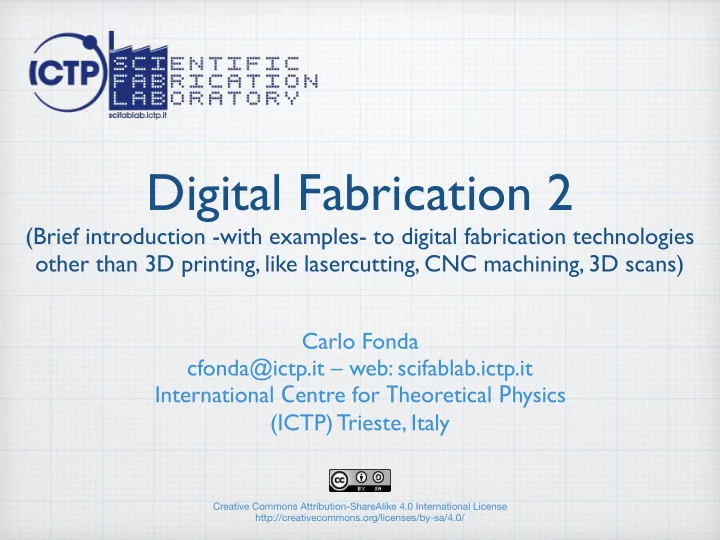

Digital Fabrication 2 (Brief introduction -with examples- to digital fabrication technologies other than 3D printing, like lasercutting, CNC machining, 3D scans) Carlo Fonda cfonda@ictp.it – web: scifablab.ictp.it International C entre for T heoretical P hysics (ICTP) Trieste, Italy Creative Commons Attribution-ShareAlike 4.0 International License http://creativecommons.org/licenses/by-sa/4.0/
Lasercutter
2D modeling (also for 3D objects) 2D (vectorial) drawings are used to "cut out" functional and artistic parts from plastic/plywood(/metal) sheets
http:/ /boxdesigner.connectionlab.org
Summary: lasercutting •Make your 2D model with CAD or vectorial drawing software (or download it from the Internet) •Save/export it as SVG/DXF •Properly configure the lasercutter software (usually it is provided with the machine), and generate the gcode •Engrave/cut
CNC
Subtractive technology
Summary: CNC •Use a CAD program to make the 3D model (or download it ;-) •Save/export it in STL format or use a CAD/CAM plugin •Set all the CAM parameters for machining, generate il gcode, setup the tools (cutting bits) •Prepare and fix the “stock” (block of raw material) and start cutting
Low-cost 3D scanners
What is a 3D scanner? • A 3D scanner is a device that scans an object or a space (like a room) to retrieve information on shapes, dimensions and possibly more (like colors). The acquired data can then be used to build a (more or less precise and faithful) digital 3D representation ( model ) of the original object or environment. • Multiple different technologies may be used for such purpose, performing triangulation and geometrical reconstruction by the mean of mechanical devices (by contact) or optical ones (streoscopic imaging, structured light, laser scanning).
How does it work? Optical scanner using digital imaging and a laser beam • A laser projects a reference geometrical pattern (usually one or more lines) on the object itself • A digital camera (or video device) acquires multiple images from different directions and perspectives (by moving/rotating the camera, the object, or both) • A software algorithm reconstructs the object by calculating 3D coordinates of many points identifying the object surface ( point cloud ) and then building a mesh.
x,y —> X,Y,Z
How does it work? Model reconstruction • An example of a free solution: meshlab • From the point cloud p i (x i ,y i ,z i ) it computes all t h e n o r m a l v e c t o r s (orthogonal to faces) and then it builds a polygonal n e t w o r k ( m e s h ) approximating the object surface
Recommend
More recommend